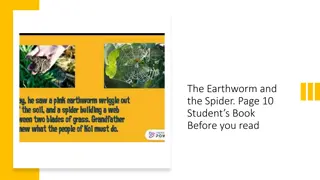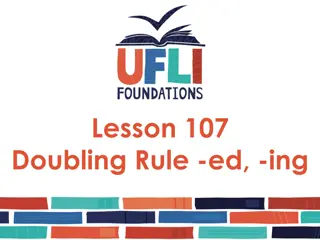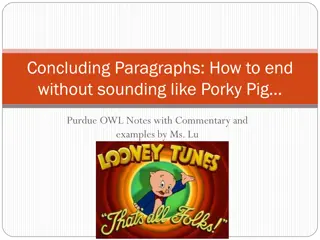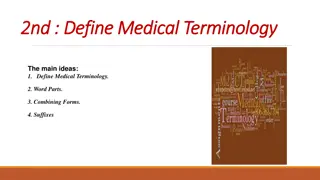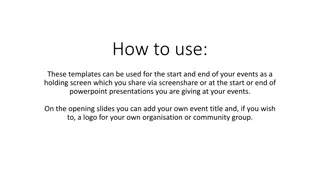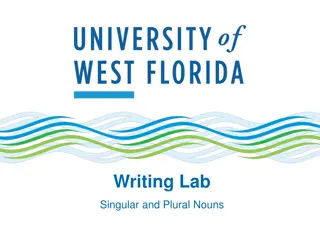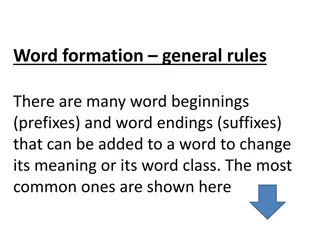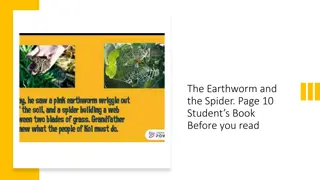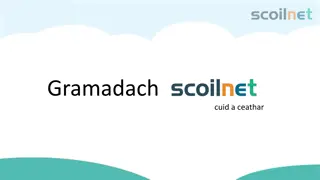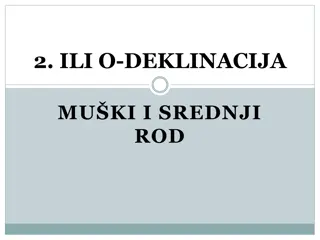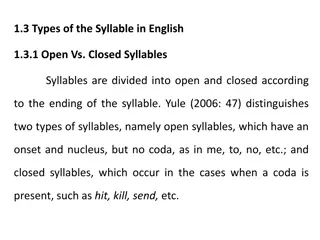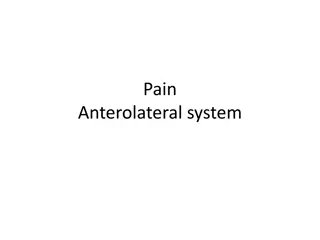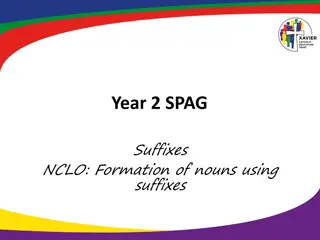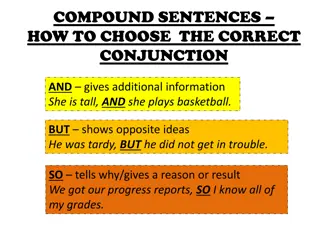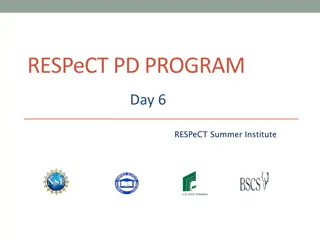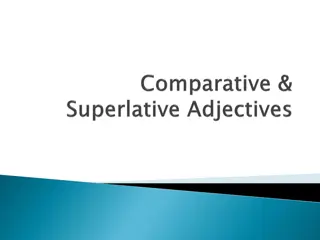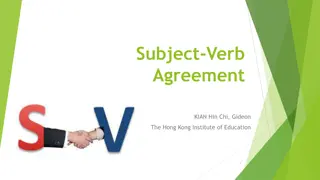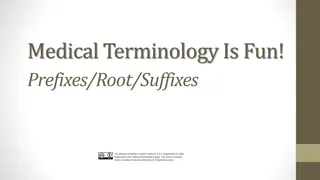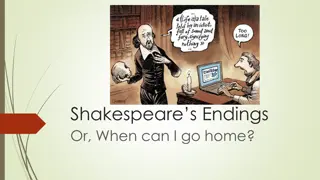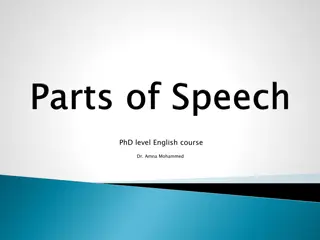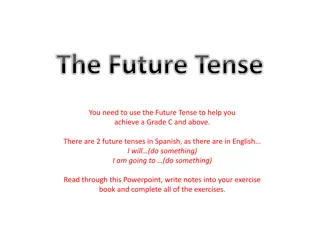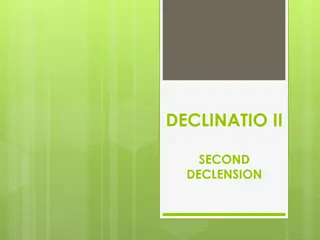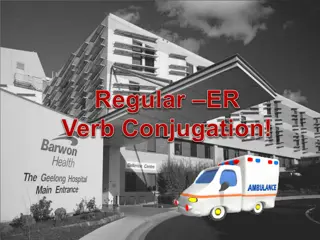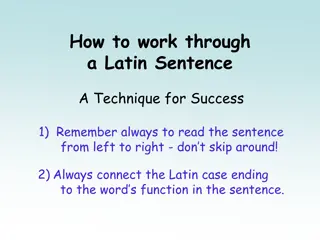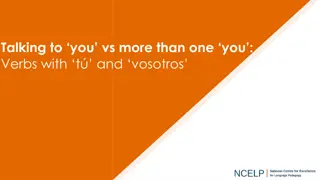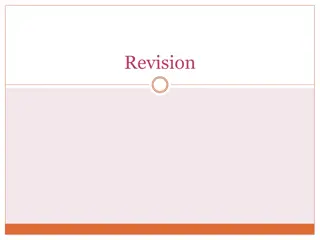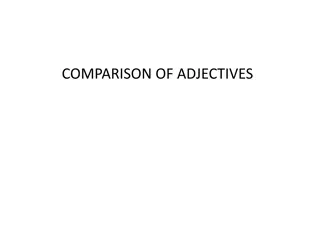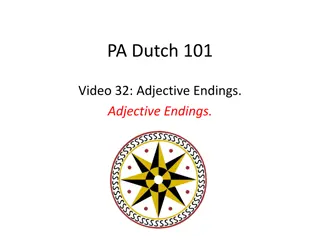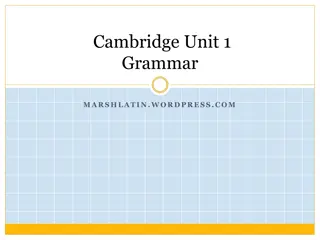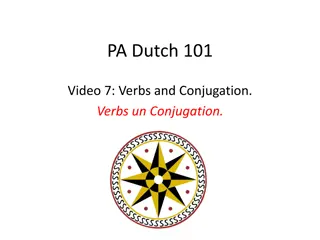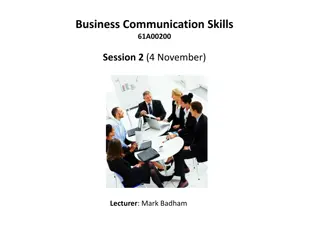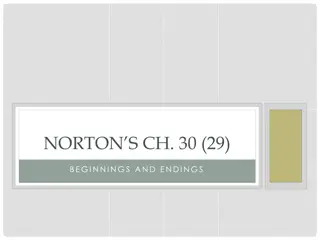Understanding Arabic Grammar: Nouns and Adjectives in Adjectival Constructions
Delve into the realm of Arabic grammar with this detailed lesson on nouns and adjectives, exploring their definitions and roles in adjectival constructions. Discover how adjectives agree with nouns in terms of gender, number, definiteness, and case endings.
1 views • 10 slides
Interactive Storytelling: The Earthworm and the Spider
Dive into the engaging tale of "The Earthworm and the Spider" through a series of thought-provoking questions and reflective insights. Explore themes of isolation, unity, and bravery as you follow the narrative from page to page, contemplating the author's intentions and the characters' motivations.
2 views • 11 slides
Understanding the Doubling Rule for Adding -ed and -ing Endings
Explore the rules for doubling consonants when adding -ed and -ing endings to words in English. This lesson provides clear examples and explanations to help you master this important aspect of grammar, leading to improved writing skills.
3 views • 81 slides
Understanding Attraction and Intimacy in Relationships
Exploring the dynamics of attraction and intimacy, this content delves into the factors that lead to friendship and romantic connections. It discusses the role of proximity, physical attractiveness, similarity, complementarity, and relationship rewards in forming bonds. Additionally, it examines the
2 views • 52 slides
Exploring Nonsense Poetry with Year One Students
Delve into the world of Nonsense poetry with Year One students as they explore rhyming words, create new endings for nursery rhymes, and decipher classic rhymes like "Mary Had a Little Lamb" and "Humpty Dumpty." Engage in creative activities that spark imagination and laughter, making learning Engli
0 views • 14 slides
Crafting Strong Conclusions: A Guide for Effective Endings
Conclusions in academic writing serve to wrap up discussions, restate key points without repetition, and possibly suggest future research directions or call to action. It is crucial to avoid introducing new information in the conclusion and aim for clarity and conciseness. This guide provides insigh
0 views • 6 slides
Understanding Medical Terminology: Key Components and Usage
Medical terminology is a specialized language used by healthcare professionals worldwide, rooted in Greek and Latin words. It comprises word parts, such as roots, prefixes, and suffixes, which are crucial for forming and understanding medical terms. The combining forms aid in pronunciation and help
2 views • 17 slides
Customizable Event Templates for Professional Presentations
Elevate your event presentations with these versatile templates designed for the start and end of your events. Customize them with your event title, organization logo, and event details. Perfect for sharing via screenshare or incorporating into your PowerPoint presentations for a polished touch. Two
0 views • 8 slides
Guidelines for Forming Singular and Plural Nouns
This collection provides clear guidelines for forming singular and plural nouns, including adding "-s", "-y endings, and "-ies". It also covers exceptions, proper nouns, and tips on pluralizing certain words. Learn when to add "-es", double consonants, or when a false pronunciation might occur.
0 views • 21 slides
Word Formation Rules and Examples
Explore the general rules of word formation, including prefixes and suffixes used to modify meanings and word classes. Learn how to create verbs, adverbs, nouns, adjectives, and more through the addition of specific endings to base words.
0 views • 17 slides
The Earthworm and the Spider: Student Book Insights
Delve into the student book "The Earthworm and the Spider" with a pre-reading image, engaging content, and post-reading reflections. Explore themes of isolation, friendship, fear, and new beginnings through questions, answers, and group activity suggestions. Uncover the story's essence through the e
0 views • 11 slides
Mastering Present Tense - Irish Verbs Practice Guide
Explore how to conjugate 1-syllable broad verbs in the present tense in Irish, including forming questions and negatives. Practice conjugation with examples and learn the rules for adding endings to verb roots. Enhance your understanding of everyday language use.
1 views • 6 slides
Noun Declensions in Latin - Rules and Examples
Explore the declensions of nouns in Latin for the second declension, including masculine and neuter genders. Learn about the endings for singular and plural forms, along with specific rules for each gender. Dive into the differences between masculine and neuter noun declensions with detailed explana
0 views • 7 slides
Understanding Syllable Types in English Language
Syllables in English are categorized into open and closed syllables based on their endings. Open syllables have an onset and nucleus without a coda, while closed syllables include a coda. Additionally, syllables can be simple (with a vowel or single consonant) or complex (with consonant clusters). T
0 views • 6 slides
Present Tense Verbs in Irish Grammar: Everyday Usage & Structure
Explore how to form and use present tense verbs in everyday Irish language with 2 to 2-syllable broad verbs, including rules for endings and changes. Learn how to ask questions, form negatives, and practice verbs for buying, hurting, and cycling with clear examples.
0 views • 6 slides
Understanding Pain: Mechanisms and Pathways
This content delves into the intricate mechanisms of pain perception, exploring the anterolateral system, nociceptors, endogenous analgesic systems, and more. It covers topics such as free nerve endings, VR1/Capsaicin receptors, referred pain, neuropathic pain, hyperalgesia, and visceral pain. The m
0 views • 15 slides
Exploring Noun Formation with Suffixes - Year 2 SPAG Activities
Dive into the world of noun formation using suffixes in this engaging Year 2 SPAG lesson. Discover how suffixes transform verbs into nouns, identify job titles by adding the suffix "-er" to action words, understand emotions through "-ment" suffixes, and recognize qualities with "-ness" endings. Enga
0 views • 10 slides
Mastering Compound Sentences: Choosing the Correct Conjunctions
In compound sentences, choosing the correct conjunction (AND, BUT, SO) is essential to convey the intended relationship between ideas. This task involves matching sentence endings to conjunctions, understanding how each conjunction functions in forming connections between clauses. Through examples a
0 views • 8 slides
Day 6 Review and Strategies for Science Content Storyline Coherence
Explore Day 6 of the RESPeCT Summer Institute focusing on reflections, lesson analysis, and deepening science content about the Sun's effect on climate. Discover strategies like STeLLA B, I, and 7 for developing coherent science storylines and enhancing student learning. Engage in discussions on les
0 views • 65 slides
Comparative and Superlative Adjectives Usage Guide
Discover how to form and use comparative and superlative adjectives to compare two or more nouns. Learn the rules for adding -er or -est endings, using "more" or "most," and irregular adjectives like "good" and "bad." Follow step-by-step formulas to create sentences with comparative and superlative
0 views • 11 slides
Understanding Subject-Verb Agreement in English Sentences
Explore the concept of subject-verb agreement through examples about the human body. Learn about singular and plural nouns affecting verb usage, common patterns in verb endings, and exceptions to verb conjugation rules in English sentences.
0 views • 15 slides
Spelling Practice for Year 3 and Year 4 Students
Improve spelling skills with word lists for Year 3 and Year 4, focusing on nouns created with suffixes -ness and -ment. Engaging exercises with missing word endings to reinforce learning. Enhance vocabulary and word recognition for young learners.
0 views • 44 slides
Comparative and Superlative in Pennsylvania Dutch 101
Covering the formation of comparative and superlative forms in Pennsylvania Dutch (PD), the content explains how PD adjectives add endings and change stem vowels to express comparison. It discusses irregular adjectives and provides examples to practice forming comparative forms in PD phrases.
0 views • 11 slides
Understanding Medical Terminology: Prefixes, Roots, and Suffixes
Exploring the world of medical terminology can be engaging and educational by delving into prefixes, root words, and suffixes. Prefixes alter the meaning of words, whereas root words are the base meanings, and suffixes modify the word endings. By combining these elements, new medical terms are forme
0 views • 9 slides
Shakespeare's Endings: A Study of Conclusions in His Works
Explore the fascinating endings of Shakespeare's plays, from tragic deaths to joyful unions. Delve into the textual construction of these endings and the aftermath when the curtains close. Discover how different genres influence the climax and resolution of Shakespeare's masterpieces.
0 views • 25 slides
Essential Elements of English Grammar Explained by Dr. Amna Mohammed
Comprehensive overview of key components in English grammar - nouns, adjectives, pronouns, verbs, conjunctions, prepositions, adverbs, and interjections - vital for improving writing skills. Detailed explanation of noun markers, endings, and the importance of verbs, including linking verbs, in sente
0 views • 37 slides
Mastering the Future Tense in Spanish
Learn how to use the future tense in Spanish to improve your language skills and achieve better grades. Explore the two future tenses in Spanish, the near future structure with "ir + infinitive," and the simple future with verb endings. Practice translating sentences to and from Spanish to strengthe
0 views • 9 slides
Nouns of II Declension in Latin Grammar
Learn about the nouns of the second declension in Latin grammar, including the different forms of masculine, feminine, and neuter nouns, along with exceptions and examples. Explore the system of endings, Greek nouns of the second declension, and suffixes used in this declension.
0 views • 21 slides
Crafting Memorable Endings for Mass Media Writers
As a mass media writer, capturing readers' attention at the beginning is crucial. However, the importance of a well-crafted ending should not be underestimated. This guide explores when and how to end effectively, emphasizing the impact a strong conclusion can have on reader engagement and overall a
0 views • 15 slides
French Verb Conjugation Explained with Examples
Learn how to conjugate French verbs by removing the -er ending and adding subject-specific endings. Discover exceptions to the rule, such as the change from je to j before a verb that starts with a vowel. Practice with marker boards, dice games, or Battleship to reinforce your understanding. Explore
0 views • 6 slides
How to Work Through a Latin Sentence: A Step-by-Step Guide
Reading Latin sentences requires a specific approach to connect the words with their functions and translations. By following a methodical process, beginners can gradually understand the structure and meaning behind Latin sentences. Starting from left to right and correlating Latin case endings with
0 views • 7 slides
Spanish Verb Endings for Addressing One Person vs. Multiple People
Spanish uses different verb endings for addressing one person (tú) and multiple people (vosotros). This resource provides examples of regular Spanish verbs with endings for one person and more than one person, as well as exercises to practice identifying the correct verb forms. Visual aids and enga
0 views • 21 slides
Latin Noun Declensions and Adjective Agreement Study Guide
Explore the intricacies of Latin 3rd declension nouns, genitive endings, and adjective agreement with this comprehensive study guide. Learn to differentiate between paradigms, identify stem variations, and make declension decisions based on gender and form. Practice forming genitives, plurals, and p
0 views • 21 slides
Understanding the Comparison of Adjectives and Their Forms
Learn how to form comparatives and superlatives of short and long adjectives, including one-syllable, two-syllable, and irregular adjectives. Discover the rules for adding endings like -er, -est, more, and most, along with examples and comparison structures using "than". Master the correct spelling
0 views • 11 slides
Understanding Adjective Endings in Pennsylvania Dutch (PA Dutch 101)
Adjectives in Pennsylvania Dutch are used to describe nouns, similar to English. Depending on the situation, adjectives either follow special endings or do not take an ending. Three main situations affect adjective endings when used with definite articles, indefinite articles, or independently. Addi
0 views • 14 slides
Understanding Latin Noun Cases and Declensions
Explore the use and distinctions of Latin noun cases (Nominative, Genitive, Dative, Accusative, Ablative), along with the concept of declensions, genders, numbers, and cases. Learn how to determine the declension, gender, number, and case of a Latin noun through its endings, and delve into examples
0 views • 23 slides
Understanding Drama: Origins, Structure, Tragedy, and Comedy
Drama is a compelling form of storytelling dating back to ancient Greek times, with plays performed for live audiences. Exploring the origins of drama, its dramatic structure involving conflict and resolution, the essence of tragedy with its tragic heroes, and the light-hearted nature of comedy with
0 views • 28 slides
Pennsylvania Dutch 101: Verbs and Conjugation
Understanding verbs and conjugation in Pennsylvania Dutch (PD) where verbs change significantly. Learn the rules and exceptions for conjugating PD verbs, including endings for different pronouns and unique cases. Proper verb conjugation is crucial for clear communication. Embrace the differences fro
2 views • 14 slides
Effective Business Communication Strategies and Skills
This session delves into various aspects of business communication, led by Lecturer Mark Badham. Topics covered include effective business writing techniques, persuasive presentation strategies, and message organization. The agenda includes practical exercises to enhance communication skills. The co
1 views • 22 slides
Understanding the Significance of Beginnings and Endings in Writing
Beginnings and endings play vital roles in capturing and maintaining reader interest. The opening sentences set the tone and purpose, offering a glimpse into the content, while conclusions provide closure. Academic introductions typically present context and a thesis statement, appealing to specific
0 views • 25 slides

